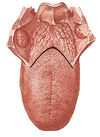Cranial Nerves Flashcards
Identify the Cranial Nerves:


Which CN are solely sensory?
** Sensory**
- Olfactory (CN I)
- Optic (CN II)
- Vestibulocochlear (CN VIII)
Which CN are solely Motor?
Motor
- Trochlear (CN IV)
- Abducens (CN VI)
- Accessory (CN XI)
- Hypoglossal (CN XII)
Which CN are mixed (Sensory/Motor/parasympathetic)?
Mixed
- Oculomotor (CN III)
- Trigeminal (CN V)
- Facial (CN VII)
- Glossopharyngeal (CN IX)
- Vagus (CN X)
CN I: Olfactory nerve
(special sensory)
- where is smell “picked up”?
- which bone does the cribiform plate belong to?
- where do the fila olfactoria synapse?

- by the fila olfactoria (olfactory epithelium)
- cribriform plate of ethmoid
- synapse on olfactory bulb (of telencephalon)
What is the ONLY cranial nerve capable of regeneration after destruction?
Olfactory nerve (CN I)
CN II: Optic nerve
(special sensory; not a real ‘nerve’)
- Carries information from what structures?
- what is the entry point for optic nerve into orbit?
- Cross-over of fibers = ??

- from retinal photoreceptors
- Optic canal
- optic chiasm
Visual field is…
…what our eyes see
** Medial** ½ of retina is…
▪ nasal = located toward the nose (STRUCTURE)
▪ receives information from **temporal visual field** (FUNCTION)
Lateral ½ of retina is…
▪ temporal = located toward the temple of skull (STRUCTURE)
▪ receives information from **nasal visual field** (FUNCTION)
Which visual field = ipsilateral visual field of an eye?
** **(e.g., right visual field of right eye)
Temporal visual field
*(wider than nasal field)
Which visual field = contralateral visual field of an eye?
(e.g., left visual field of right eye)
Nasal visual field
*(narrower than temporal field)
What do the visual fields project into?
What causes 3D, stereoscopic, binocular vision, etc?
- into retinal receptors + (R/L) optical cortices in brain
- caused by overlap of right and left visual fields

Right optic tract = Left visual field
Left optic tract = Right visual field
Optic nerve damage = ??

(monocular blindness): Blindness in one eye.
Loss of both visual fields on affected side
Optic tract damage = ??

(homonymous hemianopia): Loss of peripheral vision on opposite side
e.g., right optic tract damage → loss of vision in the left visual fields of both eyes.
Optic chiasm damage = ??

(bi-temporal hemianopia): Loss of temporal visual fields on both sides → tunnel vision
CN III: Oculomotor nerve
(motor w. parasympathetic)
- Exits cranial cavity and enters orbit through…?
- Somatic motor fibers to what 5 mm.?

- superior orbital fissure
- superior rectus (SR) + inferior rectus (IR) + medial rectus (MR) + inferior oblique (IO) + levator palpebrae superioris (LPS)
- *LPS also contains smooth muscle fibers (superior tarsal m.) that receive sympathetic innervation**
CN III: Oculomotor nerve
(motor w. parasympathetic)
- Parasympathetic innervation to…? (2mm.)
- Pre-ganglionic parasympathetic fibers to…?
- Post-ganglionic parasympathetic fibers travel via…?
- Parasympathetic innervation allows…
- ciliary m. + constrictor pupillae m.
- fibers to ciliary ganglion
- travel via short ciliary nn.
- allows: pupillary light reflex + pupillary accommodation/convergence reflex
- Constrictor + dilator pupillae* mm. are located where?
- what are their innervations? (different)
- in iris
- costrictor = parasympathetic (CNIII)
- dilator = sympathetic (superior cervical ganglion)
CN IV: Trochlear nerve
(motor)
- Exits cranial cavity and enters orbit via…?
- Somatic motor innervation to…? (1m.)

- superior orbital fissure
- superior oblique m. (SO)
CN VI: Abducens nerve
(motor)
- Exits cranial cavity and enters orbit via…?
- Somatic motor innervation to…? (1m.)

- superior orbital fissure
- lateral rectus m. (LR)
Medial rectus (MR)
- Action = eye looking straight ahead (what it’s capable of)?
- Function = When and how it is actually used?
action = Adduction
function = Adduction
Lateral rectus (LR)
- Action = eye looking straight ahead (what it’s capable of)?
- Function = When and how it is actually used?
action = Abduction
function = Abduction
Superior rectus (SR)
- Action = eye looking straight ahead (what it’s capable of)?
- Function = When and how it is actually used?
action = Elevation + Incycloduction + Adduction
function = Elevation of abducted eye
Inferior rectus (IR)
- Action = eye looking straight ahead (what it’s capable of)?
- Function = When and how it is actually used?
action = Depression + Excycloduction + Adduction
function = Depression of abducted eye
Inferior oblique (IO)
- Action = eye looking straight ahead (what it’s capable of)?
- Function = When and how it is actually used?
action = Elevation + Excycloduction + Abduction
function = Elevation of adducted eye
Superior oblique (SO)
- Action = eye looking straight ahead (what it’s capable of)?
- Function = When and how it is actually used?
action = Depression + Incycloduction + Abduction
function = Depression of adducted eye
Functions of Extraocular Muscles
*how they are actually used (and how to test them in a patient)

Pathology: Oculomotor nerve (CN III)
Paralysis of the somatic fibers of CN III leads to…
- ptosis (“dropping eyelid”)
- immobility of eyeball, which assumes an abducted (down-and-out) position
*(unopposed LR = CN VI) *


























